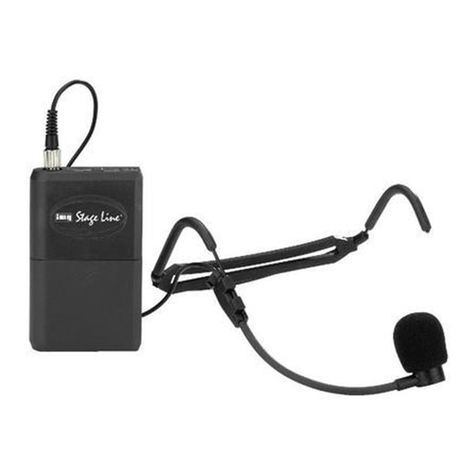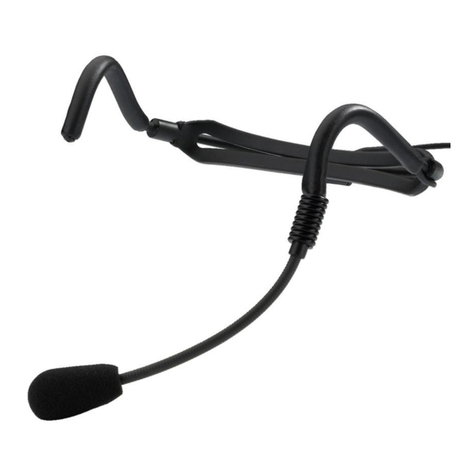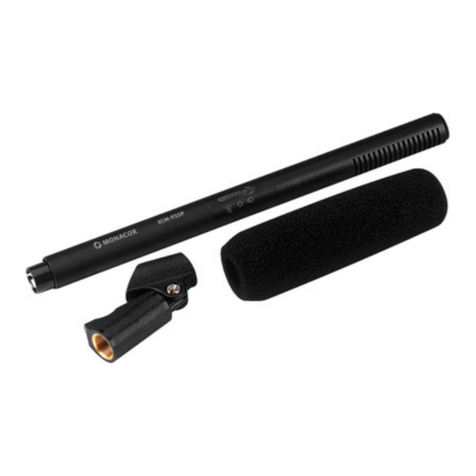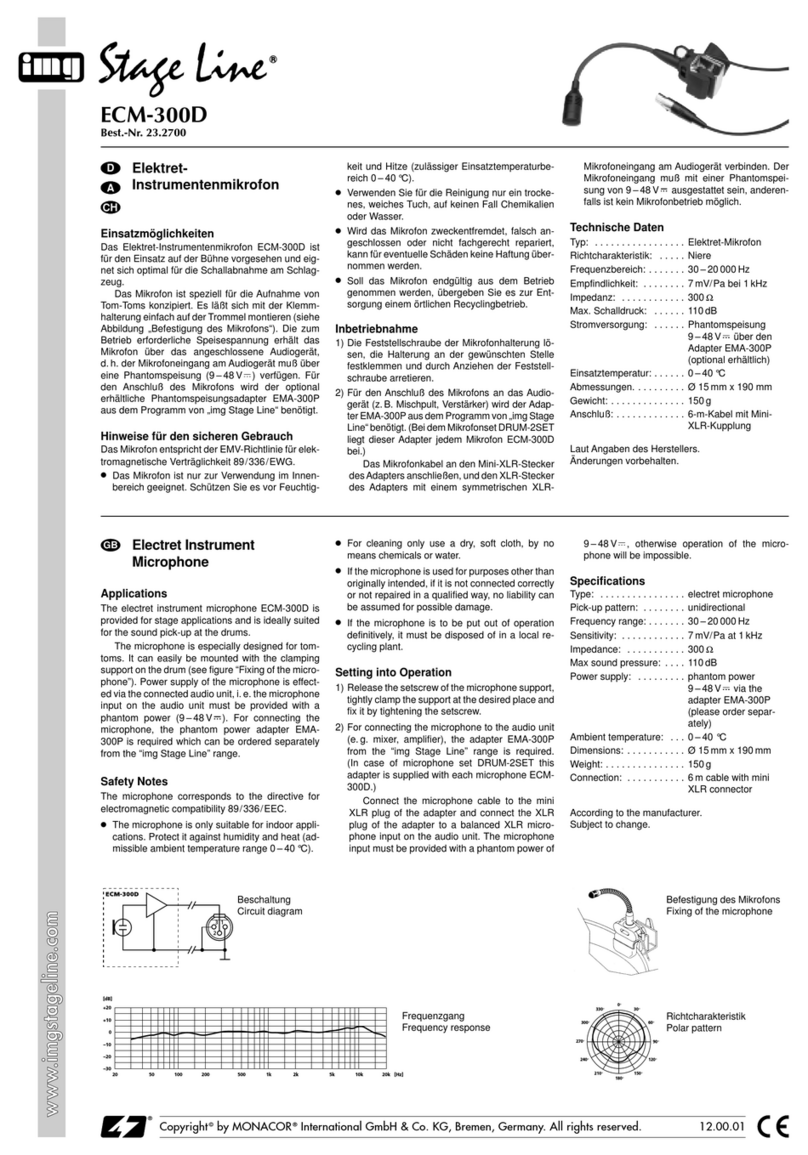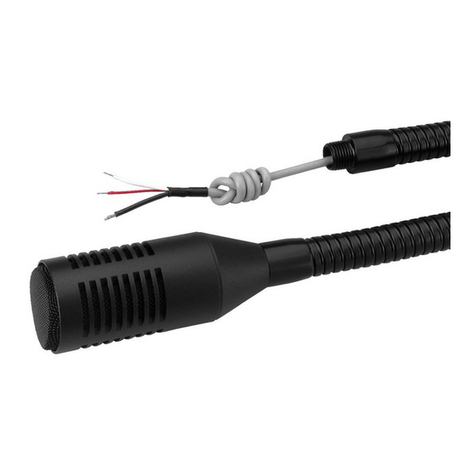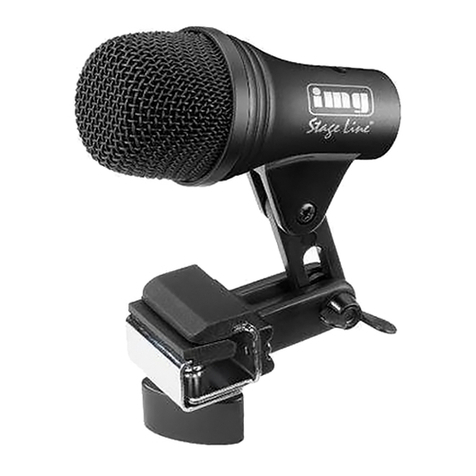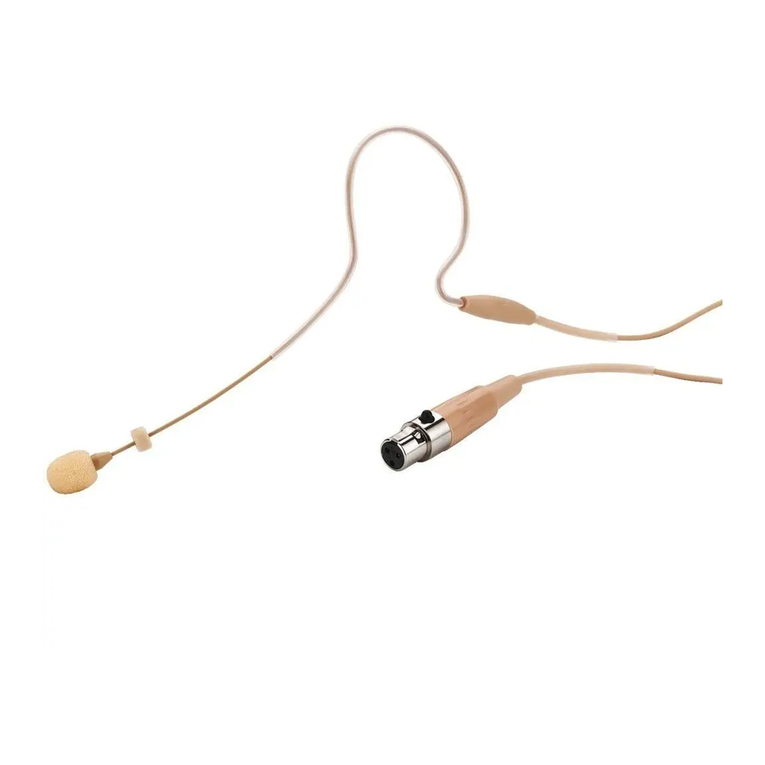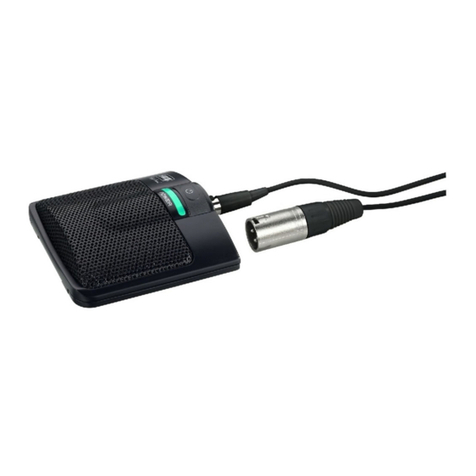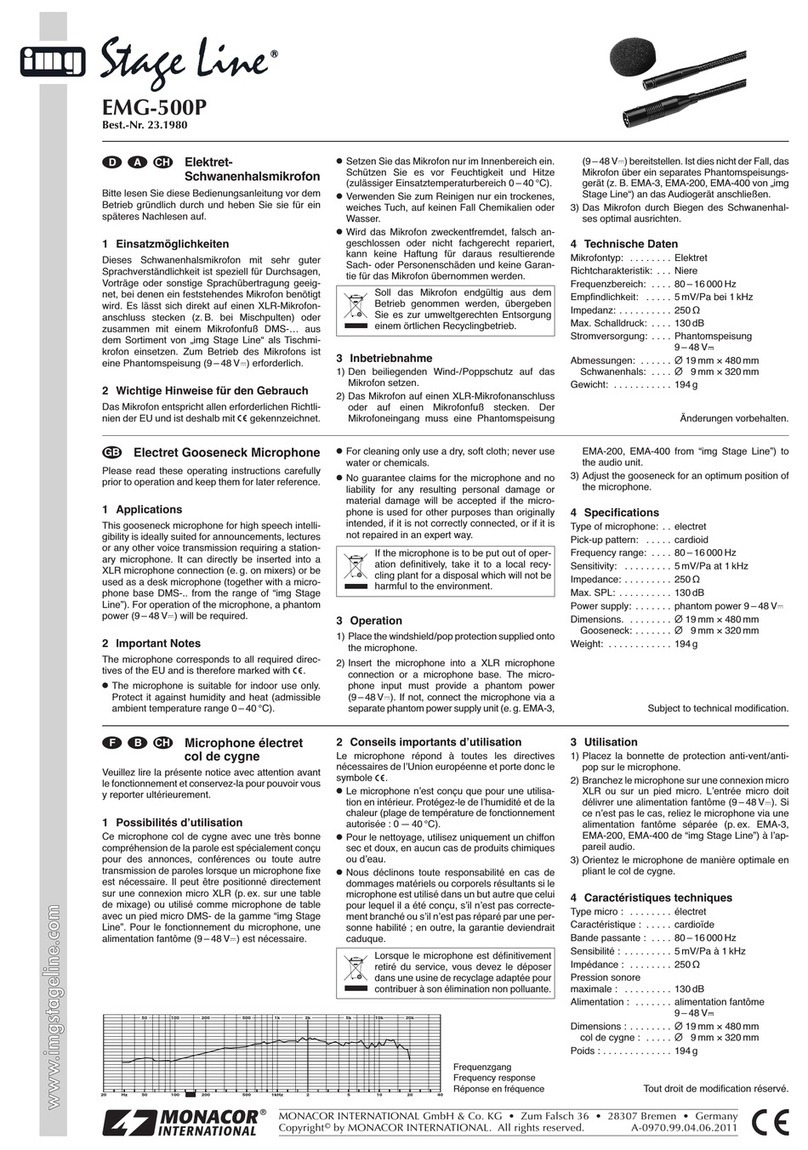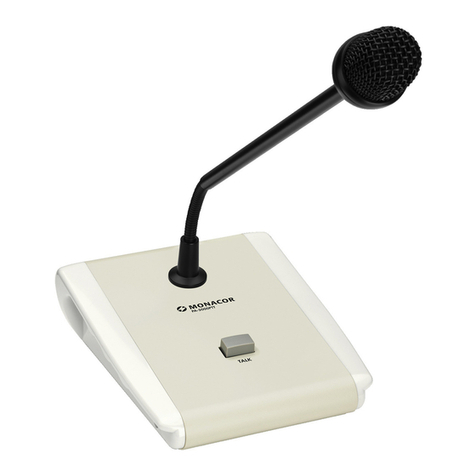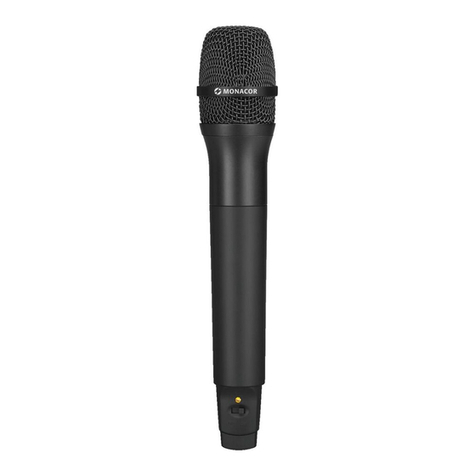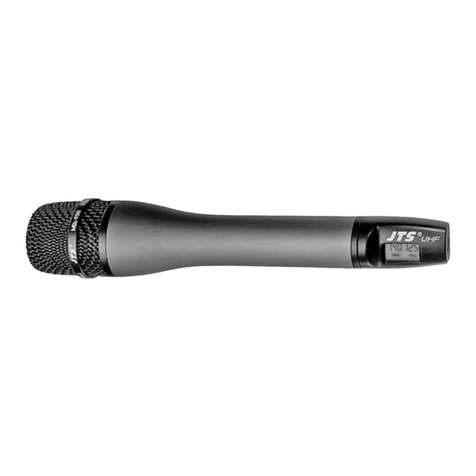Microphone électret overhead
Veuillez lire la présente notice avec attention
avant le fonctionnement et conservez-la
pour pouvoir vous y reporter ultérieurement.
1 Possibilités dʼutilisation
Le micro électret ECM-285 est conçu pour une utili-
sation sur scène et en studio et est idéal pour la prise
de son dʼinstruments (p. ex. comme micro overhead
pour cymbale ou hi-hat) et pour les applications de
discours et chant. Il peut, au choix, être alimenté par
une batterie 1,5 V ou de manière externe via lʼappa-
reil audio relié (alimentation fantôme 9 – 48 V ).
Le micro est livré avec un support avec filetage
16 mm (5⁄8″), y compris une vis dʼadaptation avec
filetage 9 mm (3⁄8″), et un câble de branchement de
6 m (le set micro DRUM-2SET est livré sans câble).
2 Conseils de sécurité
Le microphone répond à toutes les directives
nécessaires de lʼUnion Européenne et porte donc le
symbole .
GLe microphone nʼest conçu que pour une utilisa-
tion en intérieur. Protégez-le de tout type de pro-
jections dʼeau, des éclaboussures, dʼune humi-
dité élevée et de la chaleur (plage de température
de fonctionnement autorisée : 0 – 40 °C).
GPour le nettoyer, utilisez un chiffon sec et doux,
en aucun cas de produits chimiques ou dʼeau.
GNous déclinons toute responsabilité en cas de
dommages matériels ou corporels résultants si le
microphone est utilisé dans un but autre que
celui pour lequel il a été conçu, sʼil nʼest pas cor-
rectement branché ou sʼil nʼest pas réparé par
une personne habilitée ; en outre, la garantie
deviendrait caduque.
3 Fonctionnement
1) Si lʼentrée micro à laquelle le micro doit être relié
nʼest pas équipée dʼune alimentation fantôme
9 – 48V , insérez une batterie 1,5 V de type R6 :
dévissez le couvercle (partie inférieure) en le
tournant dans le sens inverse des aiguilles dʼune
montre et insérez la batterie dans le comparti-
ment en respectant la polarité (notée dans le
compartiment). Revissez le couvercle du boîtier.
En cas de non utilisation prolongée, veillez à
retirer la batterie : si elle viendrait à couler, elle
peut endommager le micro.
2) Vissez le support micro livré sur un pied pour
micro : si le pied dispose dʼun filetage 16 mm (5⁄8″),
Lorsque le microphone est définitivement
retiré du service, vous devez le déposer
dans une usine de recyclage adaptée pour
contribuer à son élimination non polluante.
Ne jetez pas directement les batteries usagées
dans la poubelle domestique, ramenez-les à un
container spécifique (p. ex. un collecteur chez
votre revendeur).
retirez la vis dʼadaptation du support et vissez
directement le support. Si le pied a un filetage
9 mm (3⁄8″), fixez le support via la vis dʼadapta-
tion. Placez le micro dans le support.
3) Branchez le micro à une entrée micro XLR de
lʼappareil audio (p. ex. table de mixage, amplifi-
cateur).
4) Pour allumer le micro, mettez lʼinterrupteur sur
“ON” ; en position “OFF”, le micro est déconnecté.
4 Caractéristiques techniques
Type : . . . . . . . . . . . . . . microphone électret
Directivité : . . . . . . . . . . unidirectionnel
Bande passante : . . . . . 80 – 15 000 Hz
Sensibilité : . . . . . . . . . . 5 mV/Pa à 1 kHz
Impédance : . . . . . . . . . 400 Ω
Pression sonore max. : . 115 dB
Alimentation : . . . . . . . . batterie 1,5 V (type R6)
ou alimentation fantôme
9–48V
Temp. dʼutilisation : . . . . 0 – 40 °C
Dimensions : . . . . . . . . . ∅26/24 mm × 195 mm
Poids : . . . . . . . . . . . . . . 110 g
Branchement : . . . . . . . XLR symétrique
Tout droit de modification réservé.
Microfono overhead
allʼelettrete
Vi preghiamo di leggere attentamente le presenti istru-
zioni prima dellʼuso e di conservarle per un uso futuro.
1 Possibilità dʼimpiego
Il microfono allʼelettrete è previsto per lʼimpiego pro-
fessionale sul palcoscenico e nello studio di registra-
zione ed è indicato in modo ottimale per la riprodu-
zione di strumenti musicali (p. es. come microfono
overhead per piatti, hi-hat) nonché per il canto e la lin-
gua parlata. A scelta, il microfono può essere alimen-
tato da una batteria 1,5 V oppure dallʼapparecchio
audio collegato (alimentazione phantom 9 – 48 V ).
Ha in dotazione un supporto con filettatura
16 mm (5⁄8″) equipaggiato con un adattatore con
filettatura 9 mm (3⁄8″) nonché. In dotazione cʼè
anche un cavo di collegamento di 6 m (il set DRUM-
2SET è senza cavo).
2 Avvertenze di sicurezza
Il microfono è conforme a tutte le direttive rilevanti
dellʼUE e pertanto porta la sigla .
GUsare il microfono solo allʼinterno di locali e pro-
teggerlo dallʼacqua gocciolante e dagli spruzzi
dʼacqua, da alta umidità dellʼaria e dal calore
(temperatura dʼimpiego ammessa fra 0 e 40 °C).
GPer la pulizia usare solo un panno morbido,
asciutto; non impiegare in nessun caso prodotti
chimici o acqua.
GNel caso dʼuso improprio, di collegamenti sba-
gliati, o di riparazione non a regola dʼarte del
microfono, non si assume nessuna responsabi-
lità per eventuali danni consequenziali a persone
o a cose e non si assume nessuna garanzia per
il microfono.
3 Messa in funzione
1) Se lʼingresso microfono dellʼapparecchio audio
non è equipaggiato con unʼalimentazione phan-
tom 9 – 48 V , montare una batteria 1,5 V del tipo
mignon (AA): svitare la parte bassa del microfono
in senso antiorario ed inserire la batteria, rispet-
tando la corretta polarità (vedi sovrastampa nel
vano batteria). Riavvitare la parte svitata.
Se il microfono non viene utilizzato per un
tempo prolungato conviene togliere la batteria
per evitare danni se la batteria perde.
2) Avvitare il supporto del microfono sul treppiede.
Se il treppiede è con filettatura 16 mm (5⁄8″), svi-
Se si desidera eliminare il microfono defi-
nitivamente, consegnarlo per lo smalti-
mento ad unʼistituzione locale per il rici-
claggio.
Non gettare le batterie scariche nei rifiuti di casa
bensì negli appositi raccoglitori.
tare lʼadattatore dal supporto ed avvitare il sup-
porto direttamente sul treppiede. Se il treppiede
è con filettatura 9 mm (3⁄8″) usare lʼadattatore per
il fissaggio. Inserire il microfono nel supporto.
3) Collegare il microfono con un ingresso microfono
XLR dellʼapparecchio audio (p. es. mixer, amplifi-
catore).
4) Per accendere il microfono spostare lʼinterruttore
da “OFF” (spento) su “ON”.
4 Dati tecnici
Tipo: . . . . . . . . . . . . . . . microfono allʼelettrete
Caratteristica: . . . . . . . . a cardioide
Banda passante: . . . . . . 80 – 15 000 Hz
Sensibilità: . . . . . . . . . . 5 mV/Pa a 1 kHz
Impedenza: . . . . . . . . . . 400 Ω
Pressione sonora max.: 115 dB
Alimentazione: . . . . . . . batteria 1,5 V mignon (AA)
oppure alimentazione
phantom 9 – 48 V
Temperatura dʼimpiego: 0 – 40 °C
Dimensioni: . . . . . . . . . . ∅26/24 mm × 195 mm
Peso: . . . . . . . . . . . . . . . 110 g
Collegamento: . . . . . . . . XLR, simmetrico
Con riserva di modifiche tecniche.
I
ECM-285
Best.-Nr. 23.2760
www.imgstageline.com
®
MONACOR INTERNATIONAL GmbH & Co. KG
•
Zum Falsch 36
•
28307 Bremen
•
Germany
Copyright
©
by MONACOR INTERNATIONAL. All rights reserved. A-0976.99.02.06.2011
Courbe de réponse
Risposta di frequenza
Caractéristique de directivité
Caratteristica direzionale

